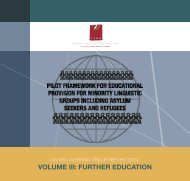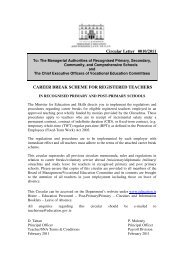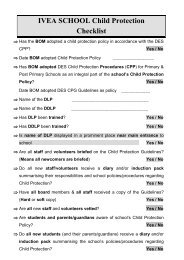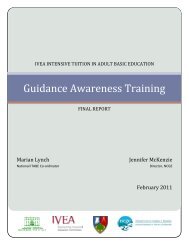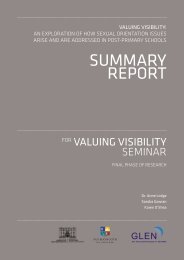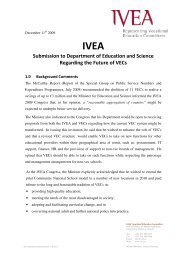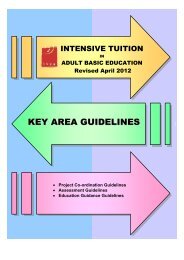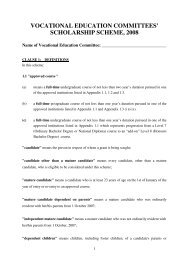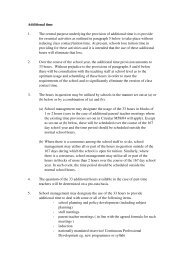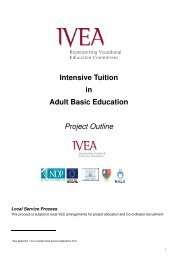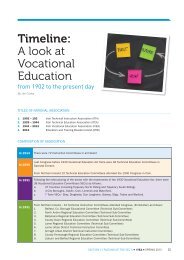Integrating Literacy into Further Education Programmes - IVEA
Integrating Literacy into Further Education Programmes - IVEA
Integrating Literacy into Further Education Programmes - IVEA
Create successful ePaper yourself
Turn your PDF publications into a flip-book with our unique Google optimized e-Paper software.
The Integration of Language, <strong>Literacy</strong> and<br />
Numeracy in VEC <strong>Further</strong> <strong>Education</strong><br />
Courses<br />
Note: This paper is the work of a NALA-<strong>IVEA</strong> working group on <strong>Integrating</strong> <strong>Literacy</strong>. The<br />
working group was established in mid 2009, to explore how VECs might better integrate basic<br />
skills, such as literacy and numeracy, <strong>into</strong> their further education programmes. At the outset,<br />
Anne O’Keeffe and David Treacy represented <strong>IVEA</strong> on the Group and Pat O’Mahony acted as<br />
secretary to the Group. More recently, Sean Conlon and Padraig Kirk joined the group. In the<br />
course of developing the paper, it was referred to both the Committee for Executive Support<br />
(CES) and the Chief Executive and <strong>Education</strong> Officers’ Association (CEEOA).<br />
Author’s Note<br />
To enhance readability, the term ‘integration of literacy’ is used to refer to the<br />
‘integration of language literacy and numeracy’. Similarly, the term ‘skill’ is used to<br />
encompass both ‘skill and competence’, where ‘competence’ refers to the capacity to<br />
apply skill and knowledge to solve real problems. The term ‘language’ refers to key<br />
words, concepts and types of verbal communication that learners need to develop in<br />
order to complete successfully their course/programme.<br />
Background<br />
The purpose of this discussion paper is fourfold.<br />
• To define what is meant by the integration of literacy in further education<br />
and training (FET) programmes.<br />
• To document for senior managers in VECs the implications that the<br />
integration of literacy would have for learners, providers, tutors/teachers<br />
and all involved in the design, promotion and delivery of FET – at levels 4<br />
to 6 on the NFQ.<br />
• To set out the practical steps that VECs would need to take to integrate<br />
literacy <strong>into</strong> their FET programmes<br />
• To facilitate and encourage VECs in the systematic adoption of the<br />
integration of literacy approach in the design, promotion and delivery of<br />
FET.<br />
Introduction<br />
International research indicates that language, literacy, and numeracy are best<br />
developed in the context of real-life activities and practices and that further education<br />
and training (FET) programmes that embed language, literacy and numeracy support<br />
1
and development within the vocational content are more effective than programmes<br />
that include the literacy support only as a separate element. This embedding process is<br />
known as the integration of language, literacy and numeracy <strong>into</strong> the design and<br />
delivery of FET programmes.<br />
In the USA, Dr Thomas G Sticht’s research provides a rich source of evidence that<br />
embedding literacy and numeracy in adult education and training delivers improved<br />
learning outcomes. 1<br />
In Australia, the government, in the mid-1990s introduced a policy to integrate<br />
literacy <strong>into</strong> all vocational education and training offered within the national training<br />
system 2 . It is a requirement that language, literacy and numeracy are built in, rather<br />
than bolted on, to all publicly funded workplace and vocational training programmes<br />
and curricula.<br />
In New Zealand, the government’s <strong>Literacy</strong>, Language and Numeracy Action Plan<br />
2008–2012 proposes a significant increase in the amount of explicit literacy and<br />
numeracy teaching that is embedded <strong>into</strong> vocational and workplace training. This is<br />
based on a thorough review of research on literacy and on adult learning, which<br />
confirmed the effectiveness of integrating or embedding literacy in vocational and<br />
workplace training 3 .<br />
In the UK, the government’s language, literacy and numeracy strategy includes a<br />
well-resourced strategy to ‘embed’ language, literacy and numeracy <strong>into</strong> education<br />
and training programmes. The National Research and Development Centre for adult<br />
literacy and numeracy (NRDC) research over several years identified the positive<br />
effect of ‘embedding’ language, literacy and numeracy <strong>into</strong> vocational education and<br />
training programmes in a range of settings. Specifically, the research shows that the<br />
1 Sticht, T. (2007) <strong>Integrating</strong> <strong>Literacy</strong> Works! Presentation at NALA-NUI Maynooth Seminar, January<br />
23 rd 2007. www.nala.ie<br />
See also: Sticht, T. G. (1983, February). <strong>Literacy</strong> and Human Resources Development at Work:<br />
Investing in the <strong>Education</strong> of Adults to Improve the Educability of Children. Alexandria, VA: Human<br />
Resources Research Organization.<br />
2 Commonwealth of Australia (2000) Built in not bolted on: Language, literacy numeracy issues in the<br />
delivery of training packages, www.anta.gov.au.<br />
3 Tertiary <strong>Education</strong> Commission (2008) <strong>Literacy</strong>, Language and Numeracy Action Plan 2008 – 2012.<br />
Wellington: Tertiary <strong>Education</strong> Commission<br />
Tertiary <strong>Education</strong> Commission (2009) Strengthening literacy and numeracy: Theoretical Framework.<br />
Wellington: Tertiary <strong>Education</strong> Commission<br />
2
integration of literacy <strong>into</strong> vocational content delivers the following improvements in<br />
learning programme outcomes 4 .<br />
• Higher retention rates.<br />
• A higher proportion of learners achieving vocational qualifications.<br />
• A higher proportion of learners achieving language, literacy and numeracy<br />
qualifications.<br />
• Students are better prepared for future job roles.<br />
Until relatively recently, literacy was generally understood to refer to the ability to read<br />
and write competently, in fairly predictable contexts. Similarly, numeracy was<br />
understood to refer to the capacity to undertake quite basic computational tasks.<br />
Today, however, this view of literacy and numeracy cannot embrace the complex and<br />
changing set of competences that adults now need to enable them live productive and<br />
fulfilling lives – in the family, in the community or in the work place. Now, it is more<br />
appropriate to think of ‘multiple literacies’, recognising that different contexts pose<br />
different literacy challenges, that technology is oftentimes a critical factor underlying<br />
these challenges and that these literacies now often involve the application of<br />
information technology skills. In addition, the traditional processes of learning that<br />
shaped our schools are changing so quickly that we are all learning how to learn again.<br />
Such change demands that we reconsider not only the teaching and learning of<br />
language, literacy and numeracy but the place of such skills and competences in the<br />
wider educational process 5 .<br />
Central to the integrating literacy approach is a recognition that the particular language,<br />
literacy and numeracy demands of different subjects and courses, at different levels, will<br />
vary, and in each case will require explicit analysis and a tailored approach.<br />
4 Casey, H. et al (2007) ‘You wouldn’t expect a maths teacher to teach plastering....’: Embedding<br />
literacy, language and numeracy in post-16 vocational programmes – the impact on learning and<br />
achievement. London: National Research and Development Centre for Adult <strong>Literacy</strong> and Numeracy.<br />
Hegarty, A., & Feeley, M. (2009) <strong>Literacy</strong>-friendly further education and training. Dublin: NALA<br />
McSkeane, E., (2009). Living <strong>Literacy</strong>: a whole-organisation approach to integrating literacy in a<br />
vocational training setting. Dublin: NALA.<br />
5 This definition of integrating literacy is adapted from the one used by Michael King, Chair of the<br />
CDVEC Working Group on <strong>Integrating</strong> <strong>Literacy</strong>, in his foreword to the CDVEC, Report for the Board of<br />
Studies, February 2011: <strong>Integrating</strong> <strong>Literacy</strong> in CDVEC FE and Adult <strong>Education</strong> Centres.<br />
3
Given the commitment of VECs to implementing best practice in all matters relevant to<br />
enhancing learner outcomes, VECs are committed to putting in place feasible plans to<br />
integrate literacy <strong>into</strong> their FET programmes.<br />
National Policy<br />
• The national policy to integrate literacy <strong>into</strong> all publicly funded education and<br />
training programmes, in so far as possible, was first adopted on foot of the<br />
publication of the National Skills Strategy (Forfás, 2007). The Skills Strategy<br />
recognised literacy, numeracy and ICT as fundamental skills that should be<br />
deliberately embedded in publicly funded education and training 6 and the Strategy<br />
placed responsibility on the relevant government departments for ensuring that<br />
these skills are both acquired and explicitly assessed at all levels of the education<br />
and training system 7 .<br />
• The Programme for Government 2011 8 committed the government to addressing<br />
‘the widespread and persistent problem of adult literacy through the integration of<br />
literacy in vocational training and through community education.”<br />
• The National Strategy to Improve <strong>Literacy</strong> and Numeracy among Children and<br />
Young People 2011-2020, <strong>Literacy</strong> And Numeracy For Learning And Life (DES, July<br />
2011), includes a commitment to integrating literacy and numeracy <strong>into</strong> all teaching<br />
in early childhood education, first and second level education and education in<br />
Youthreach centres.<br />
• The National Strategy to Improve literacy and Numeracy among Children and Young<br />
People 2011-2012 (<strong>Literacy</strong> and Numeracy for learning and Life)9 commits to<br />
building the capacity of all teachers to support the literacy and numeracy<br />
competences of their students.<br />
What Does the Integration of <strong>Literacy</strong> Entail for FET Providers<br />
6 “Basic skills (in particular, literacy), people related and conceptual skills should be prioritised and<br />
embedded <strong>into</strong> all publicly funded education and training provision in so far as possible.” Expert<br />
Group on Future Skills Needs (2007) National Skills Strategy. Dublin: Forfás (p.93).<br />
7 In reference to generic, including basic skills, “DES and DETE should act to ensure that these skills are<br />
being acquired and explicitly assessed at all levels of the education and training system.” Ibid (p101).<br />
8 Department of the Taoiseach (2011) Programme for Government 2011. Dublin: Stationery Office.<br />
9 http://www.education.ie/en/Publications/Policy-Reports/lit_num_strategy_full.pdf<br />
4
For the purposes of this paper, the integration of literacy <strong>into</strong> FET programmes is<br />
understood to include the following elements.<br />
• FET programmes are delivered in a way that allows language, literacy and numeracy<br />
to be developed as part of and at the same time as the learner is acquiring<br />
vocational skills, knowledge and competences.<br />
• The integration of literacy involves FET tutors/teachers adopting particular teaching<br />
and learning methodologies and working in partnership with literacy<br />
support/development staff.<br />
• It requires a whole-organisation approach, on the part of a provider, to ensure that:<br />
course tutors/teachers can deliver their course/s in a literacy-aware manner;<br />
tutors/teachers are aware of the literacy skills essential to their learners<br />
completing successfully the courses they are tutoring/teaching and also aware<br />
of the literacy skills essential to their learners filling the roles for which specific<br />
courses are preparing them;<br />
literacy support/development staff are aware of the specific literacy skills and<br />
practices that are embedded in the vocational courses they are supporting so<br />
they can assist individual students to develop the skills relevant to the courses<br />
they are undertaking.<br />
• It involves provider management systems that enable a working partnership<br />
between vocational and literacy staff.<br />
• <strong>Literacy</strong> support and development is integrated <strong>into</strong> all phases of the FET<br />
programme – from recruitment and induction through to progression.<br />
The integration of literacy <strong>into</strong> course design is understood to mean that, in designing<br />
an FET programme, those involved in the design process:<br />
identify the literacy and numeracy skills that are essential both to completing the<br />
course successfully and to succeeding in the job or roles for which learners are<br />
being prepared, so that in completing the course the learners may acquire the skills<br />
relevant to succeeding in those roles;<br />
eliminate any unnecessary literacy demands that may be a barrier to learning and<br />
to fair assessment;<br />
recommend teaching methods that help learners develop literacy skills as part of<br />
and alongside the core content of the FET programme; and<br />
5
ecommend a flexible working partnership between FET tutors/teachers and<br />
literacy staff in planning appropriate responses to learners’ course-related literacy<br />
needs.<br />
In practical terms, for the FET tutor/teacher, integrating literacy involves using a range<br />
of methods that take account of the different learning styles and life experiences<br />
present in the teaching group – methods that enable each learner to use his/her<br />
existing literacy strengths to engage with the course content. These tutors/teachers<br />
also use the course content as a medium for teaching and learning the new language,<br />
literacy and numeracy skills essential to mastering the vocational content of a course.<br />
This does not mean that the vocational tutor/teacher has to take sole or principal<br />
responsibility for student literacy development. Where required, literacy support staff<br />
should be available to provide expert tuition to learners and guidance to tutors/teachers<br />
in addressing course-course related and job-related literacy development needs.<br />
Implications of <strong>Integrating</strong> <strong>Literacy</strong><br />
<strong>Integrating</strong> literacy <strong>into</strong> FET programmes will make the core content of the course more<br />
accessible to more students and lead to more successful learning outcomes for all who<br />
have the ability to engage with the course content, concepts and skills, as well as the<br />
interest, motivation and aptitude for the role (in the family, in the community or in the<br />
workplace) for which the course is preparing them.<br />
<strong>Integrating</strong> literacy <strong>into</strong> both the design and delivery of FET programmes maximizes the<br />
potential for learners to participate, persist and succeed on the core vocational<br />
programme and it increases their skills and confidence in literacy. The integration of<br />
literacy:<br />
reduces unnecessary literacy barriers to learners acquiring subject specific skills,<br />
enables learners to improve their course and role specific literacy and numeracy<br />
skills in a meaningful and applicable context, and<br />
gives learners the skills and confidence necessary to complete courses, gain<br />
qualifications and progress to further education and employment.<br />
The integration of <strong>Literacy</strong> <strong>into</strong> FET programmes does not entail assuming that everyone<br />
who applies for a course at a particular level will, automatically, be able to deal with the<br />
literacy and numeracy requirements of the course nor does it mean that a learner’s<br />
literacy needs can be ignored.<br />
6<br />
Rather, it means that the course designers and
teachers/tutors work together to identify the literacy skills that their course involves<br />
and adjust the methods and materials used in tutoring/teaching the course accordingly.<br />
Benefits for FET Teachers / Tutors and <strong>Literacy</strong> Support Staff<br />
The integration of literacy <strong>into</strong> FET programmes also delivers benefits for<br />
tutors/teachers in a number of ways.<br />
• Because the language literacy and numeracy component of courses is carefully<br />
analysed in advance and the course programmes specifically address these issues in<br />
a proactive manner, the teaching more appropriately matches the learners’ needs.<br />
Consequently, the teaching is more effective and rewarding.<br />
• Where vocational tutors/teachers are more acutely aware of the literacy challenges<br />
facing their learners, they are able to tailor their teaching accordingly, thus avoiding<br />
unnecessary misunderstandings with students. The tutors/teachers can also use<br />
some of the technical course content to help their learners to improve their literacy<br />
skills. Again this should result in improved teaching and learning outcomes and, by<br />
implication, more rewarding professional experiences for tutors/teachers.<br />
• Where literacy support is provided to learners, this support is highly relevant to<br />
both the needs of the learners and the needs of the tutors/teachers, as those<br />
providing the support know exactly what literacy skills are relevant to a particular<br />
course. This should also make the work of both tutors/teachers and literacy<br />
support staff more productive and rewarding.<br />
• From the perspective of those providing literacy supports, there should also be<br />
improved professional outcomes as these tutors/teachers will now be more<br />
centrally involved in the delivery of the FET service. They will be working as part of<br />
a professional team in the delivery of a holistic FET programme tailored to meet the<br />
unique needs of individual learners – a development that sits well with the ethos of<br />
VEC literacy services.<br />
Who is Responsible for <strong>Integrating</strong> <strong>Literacy</strong><br />
7
In summary, the integration of literacy is a whole system/provider/school/centre<br />
responsibility. Those who design the FET programmes must incorporate literacy<br />
integration <strong>into</strong> the programme development process in a manner that those charged<br />
with delivering the programmes can both understand and implement. The<br />
tutors/teachers have responsibility for integrating literacy <strong>into</strong> their teaching as well as<br />
liaising with literacy support staff to maximise the integration process.<br />
The literacy support staff has responsibility for supporting the literacy integration<br />
process and, in doing so, for liaising with the vocational tutors/teachers and those<br />
managing the FET programmes. Ultimately, providers have responsibility for managing<br />
the FET programmes in a way that facilitates the integration of literacy <strong>into</strong> all such<br />
programmes. In particular, providers need to build the integration of literacy <strong>into</strong> their<br />
FET policies and plans, to monitor regularly the extent to which these policies and plans<br />
are implemented as intended and to ensure that all staff involved with the design,<br />
promotion, support and delivery of FET programmes are provided with training<br />
appropriate to their role in integrating literacy <strong>into</strong> the programmes they deliver.<br />
How <strong>Literacy</strong> Might be integrated <strong>into</strong> FET <strong>Programmes</strong> in a VEC Context 10 <br />
Attempts to integrate literacy must take a tripartite whole-centre approach directed<br />
equally at learners, staff and management. Such an approach should be underpinned by<br />
the following principles.<br />
• The teaching and learning of literacy is intrinsic to all subjects/courses/programmes.<br />
• The teaching and learning of literacy is contextualised to each subject area.<br />
• The teaching and learning of literacy is grounded in a whole-centre, collaborative<br />
and explicit approach.<br />
• The teaching and learning of literacy is grounded in initial, diagnostic assessment<br />
that identifies learners' skills and needs and is supported by on-going assessment<br />
and evaluation.<br />
• The teaching and learning of literacy is for all learners, not just those identified as<br />
having a literacy deficit.<br />
10 City of Dublin VEC, in February 2011, adopted a report from its Board of Studies regarding the<br />
integration of literacy <strong>into</strong> CDVEC FE and adult <strong>Education</strong> centres and this section draws principally on<br />
8
• The teaching and learning of literacy is driven by a differentiated view of<br />
learning that takes <strong>into</strong> account learning styles and emphasises a Plain<br />
English/language awareness approach.<br />
• The teaching and learning of literacy is a dynamic process that draws on and feeds<br />
<strong>into</strong> current educational research and practice.<br />
The following policies and practices can assist in implementing the integration of literacy<br />
<strong>into</strong> FET programmes.<br />
• Develop a whole-centre/provider literacy awareness programme.<br />
• Identify and assess individual learners’ literacy needs.<br />
• Identify the literacy demands of each course/subject area.<br />
• Develop student induction courses that facilitate each of the above.<br />
• Embed literacy in course planning and delivery.<br />
• Provide effective evaluation and summative assessment.<br />
• Implement effective literacy teaching and learning practices.<br />
• Develop appropriate teaching materials and resources.<br />
• Provide appropriate continuous professional development for all relevant staff<br />
around the whole matter of integrating literacy <strong>into</strong> FET programmes.<br />
To implement the objectives set out above, VECs may undertake the following actions.<br />
• Develop an Integrated <strong>Literacy</strong> Policy to be referenced in their five (5) year<br />
<strong>Education</strong> Plans.<br />
• Design and develop a literacy awareness pack that promotes and supports wholecentre<br />
literacy integration and provides a checklist of good practice. The pack to<br />
focus on the following areas.<br />
(a) The literacy-proofing of websites, administration forms, posters, student<br />
notices, timetables, maps, etc.<br />
(b) The need for administration, reception, and other ‘frontline’ staff to recognise<br />
literacy difficulties signals and to provide appropriate responses to these<br />
signals.<br />
how CDVEC sees the integration of literacy being implemented in its centres - see CDVEC, Report for the<br />
Board of Studies, February 2011: <strong>Integrating</strong> <strong>Literacy</strong> in CDVEC FE and Adult <strong>Education</strong> Centres.<br />
9
(c) The exploration of learners’ literacy skills and needs during induction and<br />
ongoing assessment processes.<br />
(d) The development of course literacy skills’ audits.<br />
(e) The identification of the range of literacy skills that learners require to<br />
succeed in further education and training.<br />
• Design, develop and deliver a tutor/teacher-training programme to equip<br />
tutors/teachers with the practical skills and theoretical knowledge required to<br />
integrate literacy <strong>into</strong> their specialist subject areas. Such training would enable<br />
teachers to:<br />
a. identify the literacy demands of the subjects/courses they teach;<br />
b. identify their learners’ literacy strengths and weaknesses; and<br />
c. develop teaching and learning strategies, practices, materials that take<br />
account of both (a) and (b).<br />
• Investigate and document how each of the following can help in matching learners’<br />
literacy skills with course requirements and so further integrate literacy provision:<br />
recruitment, application, interview, enrolment, initial assessment, induction, study<br />
skills and progression routes.<br />
• Develop and deliver a continuous professional development programme for<br />
principals and managers of FET colleges and centres to support them in leading a<br />
whole centre approach to integrating language, literacy and numeracy across their<br />
education and training programmes.<br />
The integration of literacy <strong>into</strong> FET programmes will require a review and revision of<br />
continuous professional development programmes for all staff involved in designing,<br />
delivering and supporting FET programmes in order to incorporate modules on the<br />
integration of literacy <strong>into</strong> those continuous professional development programmes.<br />
Concluding Remarks<br />
The integration of literacy <strong>into</strong> FET programmes can improve outcomes for learners,<br />
tutors/teachers and coordinators alike – provided the whole process is managed<br />
correctly. Doing this, in a VEC context, will involve the adoption of a whole provider<br />
approach to the literacy integration process and it will, also, require a significant<br />
10
upskilling of FET tutors/teachers, those delivering literacy and other supports to learners<br />
and those managing/coordinating these programmes.<br />
Progress in integrating literacy and numeracy <strong>into</strong> VEC FET programmes will be<br />
contingent on all involved with this work having a clear understanding of what the<br />
integration process entails and having the necessary knowledge, skills and competences<br />
to implement the process.<br />
As acknowledged above, the integration of literacy <strong>into</strong> FET programmes does not<br />
assume that all applying to participate in a particular course should be admitted<br />
automatically – irrespective of the level of their language, literacy or numeracy skills.<br />
Providers clearly retain the right to make their course admission decisions on the basis<br />
of the capacity of individual applicants to complete courses successfully and core skills,<br />
including language, literacy and numeracy, are inevitably relevant to determining that<br />
capacity. On the other hand, the core skills threshold established for entry to any<br />
particular course should relate realistically to the core skills that will be required in the<br />
role for which the course is setting out to prepare learners.<br />
As well as improving access, persistence and achievement for learners, integrating<br />
literacy <strong>into</strong> FET programmes is both timely and relevant in the current context of<br />
further education and training development. It can reinforce the interdependencies and<br />
collegiality of staff working to shared organisational goals and processes. In this way,<br />
the whole organisation approach to literacy can be a concrete example of the<br />
connectivity of different services within a VEC to support educational outcomes.<br />
Finally, it is important to recognise that the integration of literacy <strong>into</strong> FET programmes<br />
is not something that can be achieved in a short period of time. Rather it involves a<br />
process that will take time to evolve and each VEC will need to manage the process to<br />
suit its own particular circumstances.<br />
Support for the integration of language, literacy and numeracy <strong>into</strong> FET programmes, in<br />
terms of continuous professional development, is available from VEC Adult <strong>Literacy</strong><br />
services and NALA.<br />
The attached appendices are intended to provide practical guidance regarding the<br />
following.<br />
• Planning for a whole-centre approach to integrating language, literacy and<br />
numeracy in the design and delivery of FET programmes.<br />
11
• <strong>Integrating</strong> language, literacy and numeracy <strong>into</strong> teaching and learning.<br />
ENDS<br />
12
Appendix 1: Planning for a whole-college or centre<br />
approach to integrating language, literacy and<br />
numeracy in programme design and delivery<br />
Step 1<br />
Develop a policy and<br />
strategy.<br />
Step 2<br />
Set up systems and<br />
allocate resources.<br />
Step 3<br />
Identify the key language,<br />
literacy and numeracy<br />
embedded in the centre’s<br />
courses and other<br />
activities.<br />
Involve learners, all staff and<br />
management. Identify the<br />
centre’s good practices in<br />
integrating literacy and plan to<br />
build on these.<br />
Set up an integrating literacy<br />
team representative of all<br />
courses.<br />
Allocate budget.<br />
Develop communication and<br />
timetabling procedures to<br />
support teamwork between<br />
management, vocational and<br />
literacy staff.<br />
Prioritise staff development in<br />
inclusive teaching, active<br />
learning and integrating literacy.<br />
Step 4<br />
Implement and review<br />
action plans.<br />
Review methods and materials<br />
for teaching and learning and for<br />
promotion, recruitment,<br />
induction and progression.<br />
Step 5<br />
Evaluate integrating literacy<br />
strategy and plan for next<br />
phase.<br />
Select and try out procedures to<br />
integrate language, literacy and<br />
numeracy support and<br />
development across the<br />
programme.<br />
13
Note:<br />
In what follows, we mean ‘literacy’ to include language, reading, writing,<br />
numeracy and communication technology (ICT). The term ‘language’ refers to<br />
key words, concepts and types of verbal communication that learners need to<br />
develop in order to successfully complete their course or programme.<br />
Suggestions for college / centre planning to integrate literacy<br />
support and development across the service / curriculum<br />
Adopt a policy to integrate literacy support and development with<br />
programme design and delivery. Develop a strategy to implement the<br />
policy. Allocate resources, if necessary by prioritising within existing<br />
resources.<br />
Designate a coordinator from among senior staff. Form a cross-curricular<br />
team of teachers who volunteer to work together to develop, lead and<br />
evaluate an action plan to integrate literacy development with programme<br />
design and delivery.<br />
Prioritise Continuing Professional Development (CPD) for management and<br />
staff on how to integrate literacy support and development with the teaching<br />
of each subject and with other centre activities, such as promotion,<br />
recruitment, induction and progression.<br />
Ensure that the integrating literacy team includes literacy staff who have a<br />
particular interest in integrating literacy support and development with each<br />
subject.<br />
14
Design staff timetables that enable communication and teamwork between<br />
subject teachers and literacy staff, focused on the literacy involved in the main<br />
courses and in the jobs or roles to which they relate (where relevant).<br />
Plan to provide learners with access, if required, to additional course-related<br />
literacy tuition and to resources for self-directed literacy learning.<br />
Ensure that learners with specific learning difficulties have access to<br />
appropriate supports, such as assistive technologies for learning.<br />
Review and revise if necessary the centre materials and publications such as<br />
those used in promotion, registration and induction. See www.simplyput.ie.<br />
Produce centre templates for course delivery plans to help teachers identify<br />
the most important literacy objectives embedded in their subject and to plan<br />
the main teaching and learning strategies for these as part of content<br />
learning.<br />
Integrate literacy and numeracy development with the teaching and learning<br />
of induction topics. This will help achieve the goals of induction and will also<br />
give learners and teachers some early indicators of literacy and numeracy<br />
strengths and needs.<br />
Build links with employers to identify the specific literacy and numeracy<br />
demands of work placements and plan how to help learners with these.<br />
Support teachers and learners to identify and overcome any literacy barriers<br />
to fair assessment for certification in each subject area. For example, enable<br />
teachers to:<br />
- draw on the full range of assessment methods and media permitted<br />
15<br />
by the awarding body;
- teach the particular reading strategies learners will need to fully<br />
understand the assessment briefs and examination questions;<br />
- produce templates for assessment briefs to help learners experience a<br />
consistent user-friendly format across the curriculum.<br />
Explicitly evaluate the integrated literacy strategy as part of your overall<br />
programme evaluation.<br />
In planning the programme for the following year or cycle, consider the kinds<br />
of literacy support that your centre can now offer learners within each course.<br />
This will help you to know the particular kinds of literacy that learners may<br />
need on entry to the particular courses at that time.<br />
Consider transition or preparatory programmes for your main courses, to<br />
help learners develop and sustain the course-related literacy and numeracy<br />
skills.<br />
16



